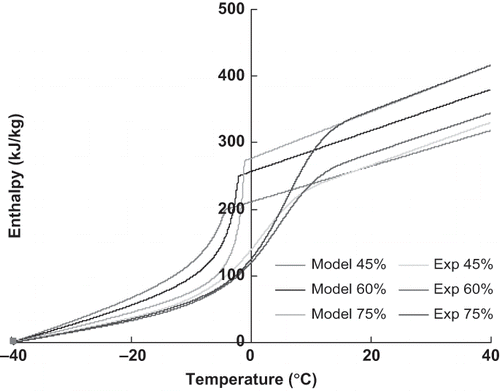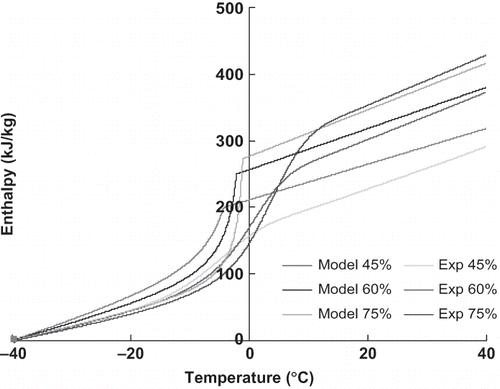Abstract
The specific heat and enthalpy of four different types of meats (Veal, Hashi, Noeimi, and Najdi) were determined in the temperature range of −40 to 40°C and moisture content range of 30–75% (wet basis). The two properties were measured by the modulated differential scanning calorimeter (MDSC). The specific heat increased almost linearly more significantly with the increasing levels of moisture content than temperature. Multiple regression models with high R2 values were developed to correlate specific heat as a function of moisture content. Statistical analysis revealed that moisture content had significant effect on specific heat of meats. Experimental enthalpy data were compared with predictive models from the literature which gave similar results but none of them was suitable to interpret MDSC results in the temperature range of phase change.
INTRODUCTION
The thermal properties of food materials especially enthalpy and specific heat as a function of process conditions are necessary for the efficient design of unit operations involving heat transfer or analysis of existing processes such as heating, cooling, freezing and thawing. In order to analyze heat transfer in meat undergoing freezing or thawing, the enthalpy and specific heat must be known or estimated accurately.[Citation1] Values of enthalpy and specific heat depend strongly on temperature and moisture content.[Citation2–4] Enthalpy and specific heat data are available in the literature for various food materials, including boneless mutton,[Citation3] shrimp meat,[Citation5] chicken breast,[Citation6] beef,[Citation7] ground beef,[Citation8] fried shrimp,[Citation9] shucked oysters,[Citation10] Tuna,[Citation11] and hamburger.[Citation12] However, the information of thermal properties viz. enthalpy and specific heat of meats under study concerning the effects of temperature and moisture content is lacking in the literature.
Enthalpy and specific heat are often measured by differential scanning calorimetry (DSC). Advantages of DSC include rapid measurement of thermal properties, multiple information can be obtained from a single thermogram,[Citation7,Citation13] and a very small sample can yield accurate results.[Citation14] Mohsenin[Citation15] and Sweat[Citation16] suggested the DSC as the best practical tool for these measurements on foods. A number of authors have reported the use of DSC for the enthalpy of fusion, apparent specific heat and unfreezable water content of food materials such as boneless mutton,[Citation3] fried shrimp,[Citation9] ice cream,[Citation13] surimi,[Citation14] sweet potato,[Citation17] and partly baked bread.[Citation18]
Due to the hot and harsh environmental conditions in Saudi Arabia as well as the absence of proper cooling and freezing installations, the shelf life of different meat variety are likely to be very short. An extensive literature search revealed that very limited data were available for meat in general and for under-utilized types Veal, Hashi, Noeimi and Najdi in particular. Hence, the present study was undertaken to determine specific heat and enthalpy of four types of meat as mentioned earlier, to analyze the effect of temperature and moisture content on both properties of meat, to develop mathematical models for the prediction of specific heat and enthalpy as a function of temperature and moisture content for the different types of meats.
MATERIALS AND METHODS
Sample Preparation
Fresh meat of Veal, Hashi, Noeimi and Najdi were obtained from a local meat company in Riyadh. The meat was taken from the ‘red’ muscles of the hip and thigh. All visible fat was removed from the muscle tissues before they were minced using an ordinary household mincer/mixer. Both the mincing and mixing processes helped to render homogeneous minced meat with the least voids when filling into the test cylinders. The minced meats were later dried to obtain the various MCs following the procedures outlined by Nesvadba and Eunson.[Citation19] The composition for the different meats is shown in .
Table 1 Composition of different meat types (g/100 g sample)
For each trial, an amount of 0.5 kg were spread out in 1-cm thick layers on several trays and dried in a wind tunnel at an air temperature 24–25°C, wind speed 1.2 m/s, and ambient humidity 55%. The mince was stirred at intervals to ensure uniform drying. After drying to the required MC (monitored by weighing the trays), the mince was either used immediately or sealed in polyethylene bags and stored in the refrigerator at 4°C for later use. Before the DSC trials, samples were well equilibrated to the test condition prior to testing. The meat samples were firm with no evidence of free water when placed in the DSC sample holder.
Modulated Differential Scanning Calorimetry (MDSC)
The modulated DSC analyses were conducted (DSC Q100, TA Instruments, Ltd., Leatherhead, England) over a temperature range from −60 to + 60°C. The linear heating rate was 5°C/min, and the heating-only modulation condition used was a period of 100s with amplitude of 1°C. This set of conditions was designed to increase sensitivity for detecting weak transitions. Baseline, temperature, heat flow, and heat capacity calibrations were carried out on the instrument using indium and sapphire[Citation20]. Triplicate meat samples of 10–20 mg were hermetically sealed (Sample Encapsulating Press, TA Instruments) in preweighed 40 ml aluminum pans. All analyses were achieved with the use of dry nitrogen gas (AGA, 99.9% N2) at 50–60 ml/min to eliminate water condensation in the measuring cell.
Specific Heat and Enthalpy Determination
Three trials were performed on each meat type. The specific heat (C p) values were obtained as a function of temperature (from −40°C to 40°C) as a direct output of the DSC Advantage for Q Series V1.2.0.147 software program (TA Instruments, Ltd., Leatherhead, England). The enthalpy change (ΔH T) between −40 and 40°C was obtained, in accordance with specifications of the equipment manufacturer. The integration was preformed using the Advantage for Q Series V1.2.0.147 software program. A heat analysis software kit was used to calculate enthalpy and heat capacity from the heat flow data.
Moisture Content Determination
Moisture content of meat was determined by oven method following the procedure described in the AOAC official methods of analysis[Citation21] for meat and meat products by the oven dry method.
Statistical Analysis
Effects of T and MC on enthalpy and specific heat were analyzed to determine a statistical difference using the General Linear Model, GLM software package.[Citation22] Least significant difference (LSD) at 5% was used to define significant differences between mean values.
RESULTS AND DISCUSSION
Specific Heat
shows MDSC specific heat curves for various meat types as at different moisture content for the temperature range studied (−40 to 40°C). The peaks in the curves were due to the phase change during the melting process. Specific heat increased rapidly as temperature approaches the initial melting temperature, indicating the region where major portions on the latent heat of fusion are removed from the product. At the initial melting temperature, the apparent specific heat function reaches a near discontinuity and increases to magnitudes for the unfrozen product at temperature below the initial melting temperature.
Figure 1 MDSC specific heat curves for different meats as a function of temperature at different moisture content levels. (A) Veal; (B) Hashi; (C) Najdi; (D) Noeimi.
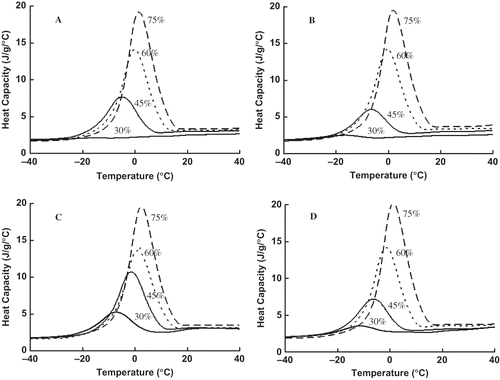
MDSC scans illustrate typical changes in specific heat below and above melting due to changes in water status. The changing peaks obtained are due to the change of water status and its link with other components. Above the freezing and refrigeration temperatures, the variation of specific heat of food products can be described sufficiently as linear functions of temperature and moisture content,[Citation2,Citation23–25] therefore, a linear regression analyses were performed on the results in order to correlate the specific heat values with temperature and moisture content using ANOVA statistical analysis[Citation22] below freezing for the different meat types. The specific heat models and the correlation coefficients are given in . The correlation coefficients ranged from 0.916 to 0.987 for the meat types studied. The results indicated that the specific heat increased with increasing temperature but more prominently at higher temperatures. In other words, the obtained results suggest the occurrence of straight-lined dependencies of the specific heat on temperature for all types below freezing. For the above freezing range, it can be seen that specific heat changed very little between 10 and 40°C and its values with the standard deviation are given in . For any particular temperature interval studied, the specific heat values increased with the increase of moisture content.
Table 2 Specific heat models above freezing temperatures as a function of moisture content for various meat types
Table 3 Specific heat values above freezing for different meat types
Multiple regression models with specific heat for the different meat types as a function of temperature (from −40 to −15°C) and moisture content (30, 45, 60, 75% w.b.) were fitted to the experimental values below freezing. The resulted models are presented in . A more general model was also fitted to correlate all the experimental values obtained for the four meat types with both temperature and moisture content. This yielded the following equation:
Table 4 Specific heat models below freezing as a function of moisture content and temperature for different meat types
Prediction models were tested against the experimental values obtained at 75% moisture content and temperature range of −40 to −15C°. The results showed a good agreement between the developed models and actual data as shown in .
Table 5 Specific heat from specific heat models for comparison with experimental data
Enthalpy
Taking the temperature datum as −40°C, enthalpy (H T) was calculated up to 40° for the four meat types as it is illustrated in to . The actual data are shown in . For all meat types, there was a rapid nonlinear increase in the enthalpy as temperatures approached the critical temperature (about −5°C). Beyond the critical temperature, further change in temperature resulted in a linear change in the enthalpy. There was a marked change at the critical temperature, in the rate of change of enthalpy with respect to temperature. The region of rapid changes in enthalpy is the zone of intensive thawing in which frozen moisture in the product is converted to liquid. It is therefore a vital region during the thawing (or freezing) process. The results show more gradual thawing in the samples with lower moisture contents. In other words, products with higher moisture contents are likely to behave like pure ice with sharper phase changes and peaks[Citation9]. The results also indicated that the enthalpy increased with increasing temperature and moisture content. The patterns of variations of enthalpy obtained in this study are typical of results reported elsewhere for similar products. For example, enthalpy values ranged from 291.36 to 428.50 kJ/kg for Noeimi meat at 40°C and moisture contents 30 to 75%. This agreed well with the reported values for different meats found in the literature.[Citation16,Citation26]
Figure 2 Experimental data for enthalpy vs temperature for Veal meat with different moisture content levels.
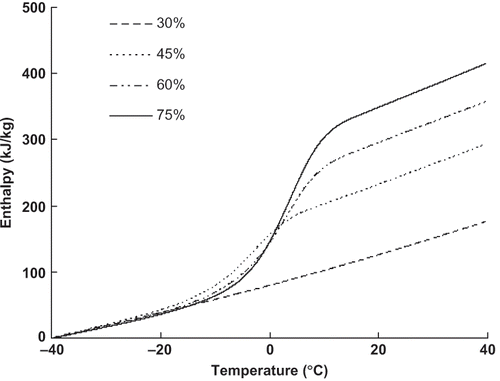
Figure 3 Experimental data for enthalpy vs temperature for Hashi meat with different moisture content levels.
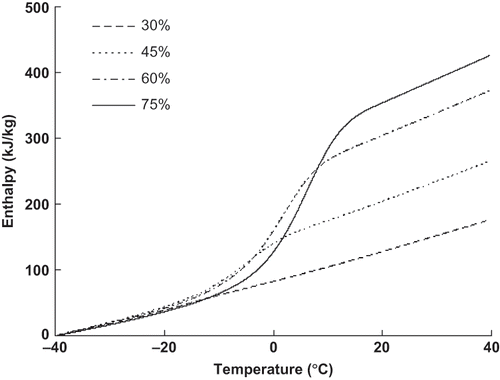
Figure 4 Experimental data for enthalpy vs temperature for Najdi meat with different moisture content levels.
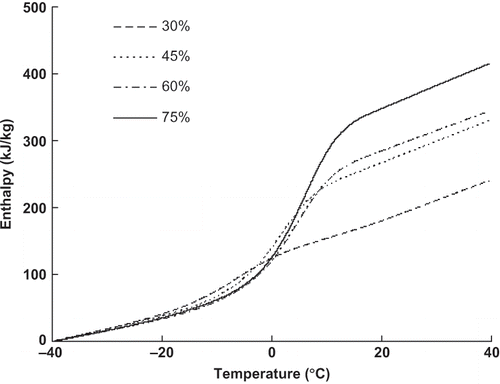
Figure 5 Experimental data for enthalpy vs temperature for Noeimi meat with different moisture content levels.
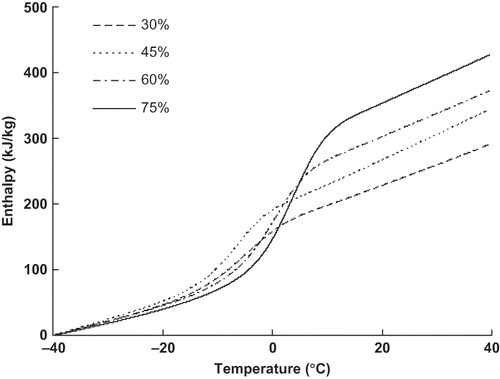
Table 6 Measured enthalpy data (kJ/kg) for all meat types (Temperature datum at −40°C)
However, food freezing operations of meat, take place over a wide range of conditions: overall heat transfer coefficients, initial and final product temperatures, environment temperature, product size and shape. It is recognized that from the engineering point of view, the real test of a food enthalpy model is whether it will allow accurate prediction of freezing times and heat loads. So the uncertainties of the calorimetric properties and models obtained through the current study should be separately evaluated and tested. Parducci and Duckworth[Citation27] mentioned that the lower moisture content was, the lower melting point obtained and the broader the melting peak was. This study confirmed this conclusion. Also it could be concluded that the onset melting point is specific for each meat type investigated in the current study.
Mathematical models for the enthalpy of meats are available in the literature.[Citation28–30] All of these models are semi-theoretical since they are based on the theory of freezing point lowering of solutions. These models need some empirical parameter such as bound water and initial freezing temperature. Three of the available models, Mellor model,[Citation25] Mascheroni model,[Citation31] and Tocci et al.[Citation32] were tested against the experimental data of enthalpy obtained here. In all cases, a reference temperature of −40°C was taken for zero enthalpy. The three models tested and their parameters are presented below, where W is the water content (kg/kg) and H cr (kJ/kg) is the enthalpy evaluated at the initial freezing temperature T cr (°C).
Mellor Model
Mascheroni Model
Tocci et al. Model
The equation was used to estimate the initial freezing temperature as a function of moisture content. For the purpose of clarity, comparison between experimental data and the data from Mascheroni model were made and shown in Figs. to . The comparison exhibited a poor agreement especially the meat samples with the least moisture content and therefore the 30% MC results were discarded. The best agreements were obtained at higher moisture contents (60 and 75% w.b.). Experimental enthalpy values show a more gradual thawing than theoretical model equations which predict a slower rate of phase change at lower temperatures and a much higher rate near Tcr . One possible explanation is given by the origin of all predictive methods, which are based on experimental data from calorimetric determinations of bigger samples (several grams).[Citation33] These samples, which were frozen much more slowly than those of DSC experiments, have a high proportion of extra cellular ice crystals that tend to behave as ‘pure ice’, thus giving a sharp phase change peak. On the other hand, DSC samples are very small, and therefore, experience rapid freezing, a fact that causes intracellular ice formation. In this case, the sample behaves during thawing ‘as a solution’ thus giving a wider phase change peak, although with a total enthalpy of phase change similar to that of bigger samples.
Figure 6 Comparison of experimental and predicted (Mascheroni model) enthalpies for Veal meat with different moisture content levels.
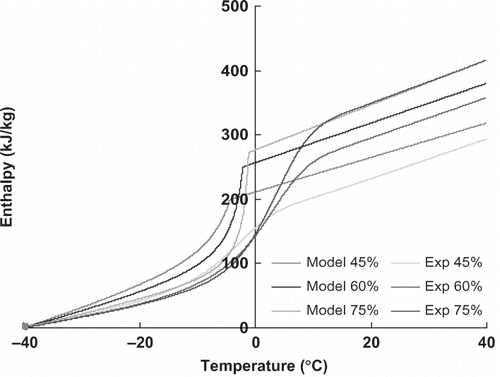
Figure 7 Comparison of experimental and predicted (Mascheroni model) enthalpies for Hashi meat with different moisture content levels.
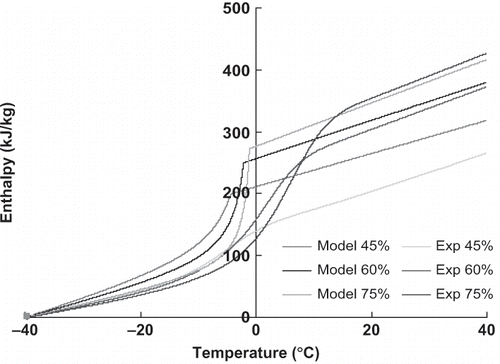
CONCLUSIONS
The specific heat and enthalpy of the four meat types were determined at the temperature range from −40 to 40C using the modulated differential scanning calorimeter. The results showed similar MDSC curves for the variation of specific heat and enthalpy with temperature and moisture content in the ranges tested. The three models tested gave similar results and none of them was especially suitable to interpret MDSC results in the temperature range of phase change.
REFERENCES
- Hidemasa , Miki and Kan-ichi , Hayakawa . 1996 . An empirical equation for estimating food enthalpy in a freezing temperature range . Lebensmittel-Wissenschaft und-Technologie , 29 ( 7 ) : 659 – 663 .
- Wallapapan , K. , Sweat , V.E. , Diehl , K.C. and Engler , C.R. 1986 . “ Thermal properties of porous foods ” . In Physical and chemical properties of foods , Edited by: Okos , M.R. 77 – 119 . St. Joseph, MI : ASAE .
- Tocci , A.M. , Flores , E.S.E. and Mascheroni , R.H. 1997 . Enthalpy, heat capacity and thermal conductivity of boneless mutton between −40 and + 40°C. . Lebensmittel–Wissenschaft und-Technologie , 30 ( 2 ) : 184 – 191 .
- Ngadi , M.O. , Mallikarjunan , P. , Chinnan , M.S. , Radhakrishnan , S. and Hung , Y.-C. 2000 . Thermal properties of shrimps, French toasts and breading . Journal of Food Process Engineering , 23 ( 1 ) : 73 – 87 .
- Karunakar , B. , Mishra , S.K. and Bandyopadhyay , S. 1998 . Specific heat and thermal conductivity of shrimp meat . Journal of Food Engineering , 37 ( 3 ) : 345 – 351 .
- Murphy , R.Y. , Marks , B.P. and Marcy , J.A. 1998 . Apparent specific heat of chicken breast patties and their constituent proteins by differential scanning calorimetry . Journal of Food Science , 63 ( 1 ) : 88 – 91 .
- Tocci , A.M. and Mascheroni , R.H. 1998 . Characteristics of differential scanning calorimetry determination of thermophysical properties of meats . Lebensm.-Wiss. U.-Technol. , 31 ( 5 ) : 418 – 426 .
- Pan , Z. and Singh , R.P. 2001 . Physical and thermal properties of ground beef during cooking . Lebensm.-Wiss. U.-Technol. , 34 ( 7 ) : 437 – 444 .
- Ngadi , M.O. , Chinnan , M.S. and Mallikarjunan , P. 2003 . Enthalpy and heat capacity of fried shrimp at freezing and refrigeration temperatures . Lebensm.-Wiss. U.-Technol. , 36 ( 1 ) : 75 – 81 .
- Hu , X. and Mallikarjunan , P. 2005 . Thermal and dielectric properties of shucked oysters . Lebensm.-Wiss. U.-Technol. , 38 ( 5 ) : 489 – 494 .
- Jianrong , Z. , Farkas , B.E. and Hale , S.A. 2001 . Thermal properties of Skipjack tuna (Katsuwonus Pelamis). . International Journal of Food Properties , 4 ( 1 ) : 81 – 90 .
- Sebnem , T. , Kumcuoglu , S. and Gaukel , V. 2007 . Apparent specific heat capacity of chilled and frozen meat products . International Journal of Food Properties , 10 ( 1 ) : 103 – 112 .
- Cogné , C. , Andrieu , J. , Laurent , P. , Besson , A. and Nocquet , J. 2003 . Experimental data and modeling of thermal properties of ice creams . Journal of Food Engineering , 58 ( 4 ) : 331 – 341 .
- Wang , D.Q. and Kolbe , E. 1991 . Thermal properties of surimi analyzed using DSC . Journal of Food Science , 56 : 302 – 308 .
- Mohesnin , N.M. 1980 . “ Thermal properties of food and agricultural materials ” . In Gordon and Breach Science Publishers New York
- Sweat , V.E. 1986 . “ Thermal properties of foods ” . In Engineering properties of foods , Edited by: Rhao , M. and Rizvi , S.S.H. New York : Marcel Dekker .
- Fasina , O.O. 2005 . Thermophysical properties of sweet potato puree at freezing and refrigeration temperatures . International Journal of Food Properties , 8 ( 1 ) : 151 – 160 .
- Hamdami , N. , Monteau , J.Y. and Le Bail , A. 2004 . Thermophysical properties evolution of French partly baked bread during freezing . Food Research International , 37 ( 7 ) : 703 – 713 .
- Nesvadba , P. and Eunson , C. 1984 . Moisture and temperature dependence of thermal diffusivity of cod minces . Journal of Food Technology , 19 : 585 – 592 .
- TA Instruments . 2001 . Modulated DSC™ Compendium, Basic theory and Experimental considerations. TA-210 , New Castle, D.E. : TA Instruments, Inc .
- Association of Official Analytical Chemists . 1990 . Official methods of analysis of the association of official analytical chemists , Washington, D.C. : AOAC .
- SAS . 1990 . SAS/STAT® user's guide , Vol. (Version 6) , Cary, N.C. : SAS Istitute In. Co .
- Schwartzberg , H.G. 1978 . “ Effective heat capacities for the freezing and thawing of food ” . In Journal of Food Science Vol. 41 , 152 – 156 .
- Ngadi , M.O. and Ikediala , J. 1998 . Thermal properties of chicken drum muscle . Journal of the Science of Food and Agriculture , 78 : 12 – 18 .
- Mellor , J.D. 1978 . Thermophysical properties of food stuffs. 2: Theoretical aspects . Bulletin of the International Institute of Refrigeration LVIII , : 569 – 584 .
- Pham , Q.T. , Wee , H.K. , Kemp , R.M. and Lindsay , D.T. 1994 . Determination of the enthalpy of foods by an adiabatic calorimeter . Journal of Food Engineering , 21 : 137 – 156 .
- Parducci , L.C. and Duckworth , R.B. 1972 . Differential thermal analysis of frozen food systems II. Micro-scale studies on egg white, cod and celery . Journal of Food Technology , 7 : 423 – 430 .
- Miles , C.A. , Van Beek , G. and Andveerkamp , C.H. 1983 . “ Calculation of thermophysical properties of foods ” . In Physical properties of foods , Edited by: Jowitt , R. 269 – 312 . London and New York : Applied Science Pub .
- Succar , J. and Hayakawa , K. 1983 . Empirical formulas for predicting thermal physical properties of food at freezing or defrosting temperatures . Lebensmittel-Wissenschaft und Technologie , 16 : 326 – 331 .
- Sanz , P.D. , Alonso , M.D. and Mascheroni , R.H. 1987 . Thermophysical properties of meat products: general bibliography and experimental values . Transactions of the ASAE , 30 : 283 – 289 . 296
- Mascheroni , R.H. 1977 . “ Transferencia de calor con simultáneo cambio de fase en tejidos cárneos ” . In Ph.D. Thesis, La Plata National University Argentina
- Tocci , A.M. , Flores , E.S.E. and Mascheroni , R.H. 1997 . Enthalpy, heat capacity and thermal conductivity of boneless mutton at low and ambient temperatures . Lebensmittel-Wissenschaft und-Technologie , 30 : 184 – 191 .
- Tocci , A.M. and Mascheroni , R.H. 1998 . Characteristics of differential scanning calorimetry determination of thermophysical properties of meats . Lebensmittel-Wissenschaft und-Technologie , 31 ( 5 ) : 418 – 426 .
